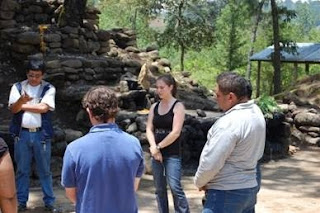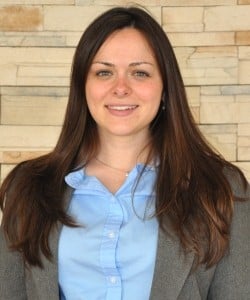 One of the advantages of being a Fulbright student is the opportunity to collaborate with other Fulbrighters. Through the exchange of ideas and sharing of diverse talents, Fulbrighters can accomplish great things together. When I teamed up with Kara Andrade, a fellow Fulbright student in Guatemala, we organized a symposium that brought leaders of historically conflicting religions together to foster an open dialogue promoting positive exchange, respect, and understanding.
One of the advantages of being a Fulbright student is the opportunity to collaborate with other Fulbrighters. Through the exchange of ideas and sharing of diverse talents, Fulbrighters can accomplish great things together. When I teamed up with Kara Andrade, a fellow Fulbright student in Guatemala, we organized a symposium that brought leaders of historically conflicting religions together to foster an open dialogue promoting positive exchange, respect, and understanding.
Guatemala is a country built on differences. While many nations make a claim to homogeneity for the sake of unification, Guatemala has always been a country of plurality. Home to a large Mestizo or Ladino community, there is an even larger Mayan contingent – around 60 percent of the total population. And within the Mayan population, there are 21 different ethno-linguistic groups.
The face of religion is changing in Guatemala. Historically, one of the most Catholic countries in Latin America, it is well on its way to becoming the region’s first evangelical country and is currently second after Brazil (according to a report by Ayuda a la Iglesia Necesitada (ACN) in 2009). Now, 50 percent of inhabitants are evangelical, or “non-Catholic Christians,” who attend dozens of Protestant denomination churches. Mayan spirituality, on the other hand, is more difficult to measure because while the majority of Mayans practice some form, they also often practice another religion.
It is precisely this environment of religious, ethnic and linguistic plurality that our symposium attempted to mediate. On July 17, 2010, fellow Fulbrighter Kara Andrade and I held a symposium entitled, “El Día y El Destino: Desde los Derechos Hasta el 2012,” (“Day and Destiny: From Rights to 2012”) in which we heard from a panel of six religious leaders: three Mayan Daykeepers (leaders of Mayan community spiritual practices), an Evangelical pastor, a director of a Christian community organization, and a Catholic priest. We brought together leaders of these often opposing groups to speak about what role religion might play in Guatemala’s future. Will religion continue to divide the population? Will Mayan spiritual practices only be recognized through tourism? Or, will these leaders, with all of their differences, be a source of positive guidance and unification for future generations?
A Mayan Daykeeper once told me that Guatemala is a country of great faith. As a country that has been battered by a recent four-decade civil war and that is still plagued by ongoing violence, many people look to ritual practices of faith for answers. These leaders, both Mayan and Ladino, were given space to speak publicly about what role they and their practices might have in leading the way to Guatemala’s future. While discrete answers are rarely arrived at easily, the symposium revealed that religious groups are not insulated according to ethnic groups. A Mayan may be Catholic or another Christian denomination, or practice traditional, spiritual beliefs while remaining proud of their Mayan heritage.
Regardless of ethnic or religious background, all Guatemalans share a desire for mutual respect and partnership.
 As Fulbrighters, this symposium put us in contact with members of the Guatemalan religious community with whom we would not have otherwise interacted, making the overall experience much richer. More importantly, it became a tangible way to give back to the community that had shared so much with us. The connections afforded to us through the U.S. Embassy made it possible to find a venue for our event and identify leaders to serve on the panel. While the symposium was a venture outside of our original Fulbright projects – mine involves studying Mayan spiritual practices and Kara’s research is on fostering community journalism – the effects were far-reaching. By using the resources available to us through Fulbright, we were able to serve the community in which we have been living: we provided a means for them to take steps toward collaboration, agreement, and understanding.
As Fulbrighters, this symposium put us in contact with members of the Guatemalan religious community with whom we would not have otherwise interacted, making the overall experience much richer. More importantly, it became a tangible way to give back to the community that had shared so much with us. The connections afforded to us through the U.S. Embassy made it possible to find a venue for our event and identify leaders to serve on the panel. While the symposium was a venture outside of our original Fulbright projects – mine involves studying Mayan spiritual practices and Kara’s research is on fostering community journalism – the effects were far-reaching. By using the resources available to us through Fulbright, we were able to serve the community in which we have been living: we provided a means for them to take steps toward collaboration, agreement, and understanding.
The symposium’s recorded webcast (in Spanish) can be found on the HablaGuate website.
A few tips for applicants:
1. Take advantage of the many available resources in your host country or find a way to build connections before you apply. Does your host country have a language program you can enroll in? A project you can volunteer for through an NGO? Once you have your project in mind and know the community in which you will be working, it’s important to show that you have their support in your Fulbright application. This is mainly accomplished through your letter(s) of affiliation. Additionally, the connections you build early on will help you to be much more productive once you arrive.
2. Make sure you are very clear in describing how your project is unique. Will you be doing something that is needed greatly, offering a new perspective on an issue or working in a neglected area?
3. Have a clear plan as to how cultural exchange will regularly take place. What will you be giving back to the community, and how?
4. Don’t give up. If you don’t make the cut one year, visit the host country if possible, build connections, and revise your project for next year’s Fulbright U.S. Student Program competition. Often, new experiences will give you fresh ideas that are even better than your original ones.
Top photo: Elizabeth R. Bell, 2009-2010, Guatemala (center), participates in a Mayan ceremony at the Iximche’ ruins, a sacred space in part of the pre-Columbian Kaqchikel-Maya capital city, that is still used today.
Bottom photo: Elizabeth R. Bell, 2009-2010, Guatemala, and her infant son admire the colorful sawdust alfombras (carpets) before watching the Catholic processions in La Antigua, Guatemala, held during Lent.
 Megan Banick’s Fulbright Public Policy Fellowship placement is in the Guatemalan Ministry of Education as an Educational Researcher consulting on various education topics such as intercultural-bilingual education quality, civic education through student government, and international standardized testing. She is also leading a project for the Ministry on academic disinterest and cultural perceptions in Guatemala. Previously interning at a local NGO, she supported an agriculture and microbusiness training program in the same rural area where her current work will take place. Further, as an observer of a local mayoral candidate’s campaign, she gained a stronger understanding of the complex challenges facing democracy and public participation in rural, indigenous areas.
Megan Banick’s Fulbright Public Policy Fellowship placement is in the Guatemalan Ministry of Education as an Educational Researcher consulting on various education topics such as intercultural-bilingual education quality, civic education through student government, and international standardized testing. She is also leading a project for the Ministry on academic disinterest and cultural perceptions in Guatemala. Previously interning at a local NGO, she supported an agriculture and microbusiness training program in the same rural area where her current work will take place. Further, as an observer of a local mayoral candidate’s campaign, she gained a stronger understanding of the complex challenges facing democracy and public participation in rural, indigenous areas.